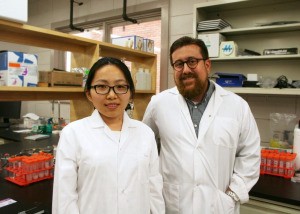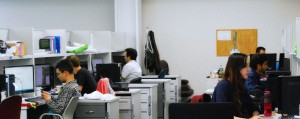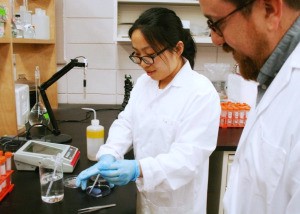
Michael Serpe with PhD student Xue Li, who is part of his research group and will be defending her thesis this summer.As the old saying goes, two heads are better than one, so imagine what two research powerhouses can do working together. That's the idea behind the University of Alberta's strong partnerships all over the world - global networks that allow us to better tackle some of the biggest issues of our time.
With this in mind, and through the support of the Government of Alberta, the U of A has developed the China Opportunity Fund, which fuels science and technology research programs like the UAlberta-China Joint Research Labs (JRL) and the Sino-Canadian Energy and Environment Research and Education Initiative (SCENEREI). As a result of these programs, important research collaborations have grown rapidly between Alberta and China, in a wide range of areas of strategic interest to both: energy, environment, nanotechnology, life sciences, and information and communication technologies.
The benefits that come out of these research projects are tangible. Through these initiatives, researchers have made major breakthroughs in health and environmental issues such as biodiversity, climate change and water toxicology. As well, these partnerships are instrumental in developing new technologies that are quickly becoming essential in the fight against energy and environmental challenges. The involvement of graduate students also means that Alberta has built up its base of highly qualified researchers and innovative thinkers.
The JRL program was developed in 2005 with the Chinese Ministry of Science and Technology (MOST) to support the U of A's collaboration with China's top research labs. With additional financial support from the Alberta government, the U of A created the China Opportunity Fund, which is managed by U of A International and the VP (Research) office. Fund activities expanded in 2015 to encompass SCENEREI, which had been officially launched with Tsinghua University in 2012.
Through the fund, U of A professors have been awarded over $2 million for joint research projects. Additionally, more than $1 million has been committed by faculties and U of A researchers, with their counterparts supporting activities on the Chinese side.
These research projects include the work being carried out by the labs of Amit Kumar and Michael Serpe. In Kumar's mechanical engineering lab, his research team is exploring ways to diversify energy exports to China while reducing greenhouse gas emissions. As he explains, his research "looks at costs and greenhouse gas emissions mitigation in the delivery of liquefied natural gas, bitumen and synthetic crude oil to China. The funding will be used to hire graduate and post-doctoral students who will do research work here and interact with State Key Labs and Tsinghua University in China."

Dr Kumar's students working in new engineering facilitiesIn Serpe's chemistry lab, the China Opportunity Fund has enabled him to develop numerous academic relationships and friendships with researchers across China. In particular, the funding will allow him to further solidify his collaboration with Tsinghua University's Xi Zhang by "providing funds to facilitate student exchanges and support high-quality research in both Canada and China." By doing so, his international team will be able to help solve health and environmental problems by furthering our understanding of responsive polymer behaviour.

Currently, 23 SCENEREI joint research projects like Kumar's and Serpe's are underway, and there have been dozens of projects with State Key Labs and National Labs funded over the past decade. In the most recent round of funding awarded in May, 20 new projects were supported, including 11 with Tsinghua University and 15 with MOST labs. These projects are harnessing the resident expertise of both the U of A and China to explore topics surrounding clean energy, energy policy, energy transportation and the environment.
"The China Opportunity Fund has, over the years, facilitated numerous collaborative research projects between distinguished scholars in China and the U of A," says Vice-Provost and Associate Vice-president (International) Britta Baron. "The fund focuses on research projects that will have immediate impact on the quality of the lives, prosperity and health of people in Canada and China. These opportunities link and thus augment the expertise and creative energy of researchers who are many thousands of kilometres apart, ultimately enhancing the well-being of the people of Canada and China."
Vice-president (Research) Lorne Babiuk echoes this sentiment when discussing the SCENEREI program, which has linked us with Tsinghua, the "MIT of China."
"It's China's top university and the best in the world in energy," he explains. "Many top scientists and engineers in China and at the U of A are Tsinghua alumni, as are many Chinese government leaders. So Tsinghua plays a key role in both China and Canada, in science, technology, and research and development."
As the province continues to grow and the U of A further strengthens its position as a leader in worldwide collaborative research, time will only tell what amazing things will be achieved on our campuses.

Alyssa Ott - Marketing & Social Media Coordinator, University of Alberta International
Alyssa is a proud alumna of the U of A Bachelor of Arts in Design & Visual Communication. She recently spent a year abroad in the UK working as a digital marketing executive and exploring different areas in Europe. Alyssa is passionate about creating creative and sustainable cultures, and loves to bring a unique spin to all things digital.